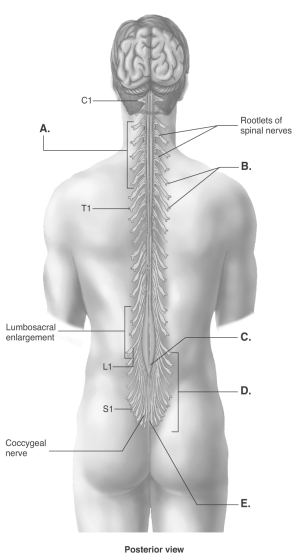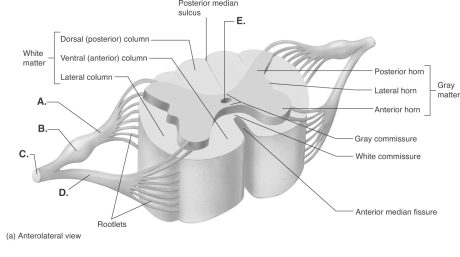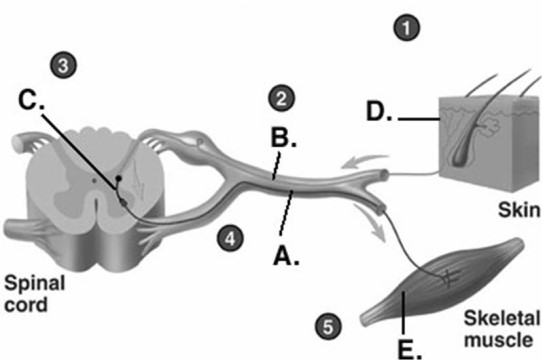A) stretch reflex
B) Golgi tendon reflex
C) withdrawal reflex
D) crossed extensor reflex
E) reciprocal innervation
Correct Answer

verified
Correct Answer
verified
Multiple Choice
 -What does "B" represent?
-What does "B" represent?
A) spinal nerves
B) conus medullaris
C) cervical enlargement
D) filium terminale
E) cauda equina
Correct Answer

verified
Correct Answer
verified
Multiple Choice
The muscles of the back contract to straighten so that you sit at a more erect posture and subsequently the muscles are suddenly stretched as you nod off.Which of the following best represents the sequence of events when you start to nod off? (1) muscles of the back are stretched (2) the muscle spindle is stretched (3) action potentials in sensory neurons of the muscle spindles increase (4) action potentials in alpha motor neurons of skeletal muscle fibers increase (5) skeletal muscle of the back contract
A) 1,2,3,4,5
B) 1,5,2,3,4
C) 1,5,3,2,4
D) 5,2,3,4,1
E) 4,5,3,2,1
Correct Answer

verified
Correct Answer
verified
Multiple Choice
 -What does "C" represent?
-What does "C" represent?
A) spinal nerves
B) conus medullaris
C) cervical enlargement
D) filium terminale
E) cauda equina
Correct Answer

verified
Correct Answer
verified
Short Answer
The largest peripheral nerve in the body is the ______ nerve.
Correct Answer

verified
Correct Answer
verified
Multiple Choice
Reciprocal innervation
A) is associated with the Golgi tendon reflex.
B) stimulates antagonistic muscles.
C) results in reduced resistance to the reflex.
D) reinforces the withdrawal reflex.
E) inhibits the stretch reflex.
Correct Answer

verified
Correct Answer
verified
Multiple Choice
The perineurium
A) surrounds nerve cell bodies.
B) surrounds individual axons and their Schwann cells.
C) bundles axons into fascicles.
D) bundles fascicles into nerves.
E) bundles fascicles into axons.
Correct Answer

verified
Correct Answer
verified
Multiple Choice
The cross-sectional view of the spinal cord reveals white matter on the
A) inside,gray matter on the outside,and a dorsal motor root.
B) outside,gray matter on the inside,and a ventral motor root.
C) inside,gray matter on the outside,and a dorsal sensory root.
D) outside,gray matter on the inside,and a ventral sensory root.
Correct Answer

verified
Correct Answer
verified
Multiple Choice
When a person hits their funny bone,they cause temporary damage to the _____ nerve.
A) axillary
B) radial
C) musculocutaneous
D) ulnar
E) median
Correct Answer

verified
Correct Answer
verified
Multiple Choice
 -What does "B" represent?
-What does "B" represent?
A) central canal
B) ventral root
C) dorsal root ganglion
D) spinal nerve
E) dorsal root
Correct Answer

verified
Correct Answer
verified
Multiple Choice
Intercostal nerves are formed from the
A) thoracic plexus.
B) ventral rami of thoracic spinal nerves.
C) dorsal rami of thoracic spinal nerves.
D) rami communicans of the thoracic spinal nerves.
E) cervical plexus.
Correct Answer

verified
Correct Answer
verified
Multiple Choice
The middle,thin,spider-like meninx is the
A) dura mater.
B) pia mater.
C) ectomater.
D) arachnoid mater.
Correct Answer

verified
Correct Answer
verified
Multiple Choice
Match the nerve to the correct function. -musculocutaneous nerve
A) provides motor innervation to the biceps brachii
B) innervates two forearm muscles plus most of the intrinsic hand muscles
C) innervates all but one of the flexor muscles of the forearm and most of the hand muscles near the thumb
D) innervates the deltoid and teres minor muscles
E) innervates the triceps brachii
Correct Answer

verified
Correct Answer
verified
Multiple Choice
The sensory root of a spinal nerve is also referred to as
A) anterior root.
B) dorsal root.
C) efferent root.
D) ventral root.
E) lateral root.
Correct Answer

verified
Correct Answer
verified
Multiple Choice
Muscle spindles
A) are innervated by gamma motor neurons.
B) originate in the spinal cord.
C) are specialized nerve cells.
D) are found encapsulated in nerve endings.
E) are innervated by alpha motor neurons.
Correct Answer

verified
Correct Answer
verified
Multiple Choice
When someone taps you on your shoulder,they stimulate the ____ nerve.
A) axillary
B) brachial
C) radial
D) musculocutaneous
E) ulnar
Correct Answer

verified
Correct Answer
verified
Multiple Choice
Initiating the withdrawal reflex in both legs at the same time would cause one to
A) maintain posture longer.
B) fall.
C) decrease muscle tension.
D) develop resistance in one limb and reduce resistance in the other.
E) hop.
Correct Answer

verified
Correct Answer
verified
Multiple Choice
 -Label component "D" on the reflex arc.
-Label component "D" on the reflex arc.
A) sensory receptor
B) effector organ
C) sensory neuron
D) motor neuron
E) interneuron
Correct Answer

verified
Correct Answer
verified
Multiple Choice
What structure makes the dorsal root different from the ventral root?
A) The dorsal root has a ganglion.
B) The dorsal root has a tract.
C) The dorsal root has a nucleus.
D) The dorsal root appears the same as the ventral root.
Correct Answer

verified
Correct Answer
verified
Multiple Choice
Because the stretch reflexes can be traced back along certain spinal nerve routes,
A) they are not used in diagnosis of brain potential brain damage.
B) they are only useful for diagnosis if there has been damage to the spinal cord.
C) it is possible to determine what level of the spinal cord may have been damaged.
D) they are only helpful when diagnosing problems in the extremities.
E) they are only helpful if the patient is conscious.
Correct Answer

verified
Correct Answer
verified
Showing 81 - 100 of 124
Related Exams